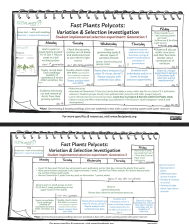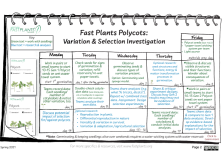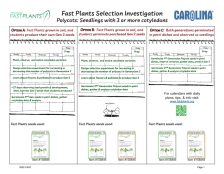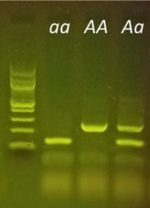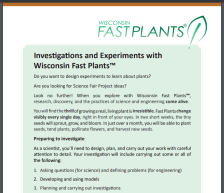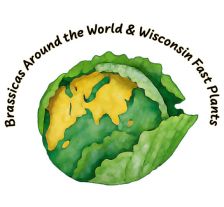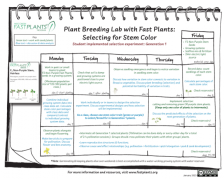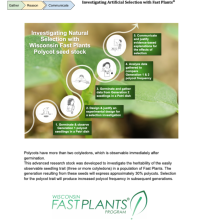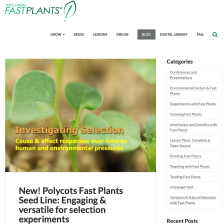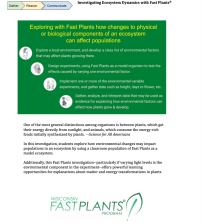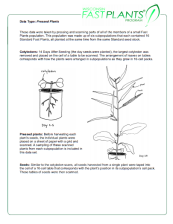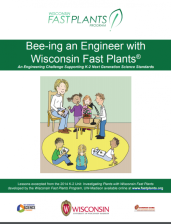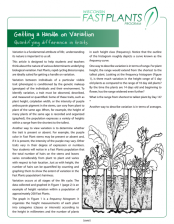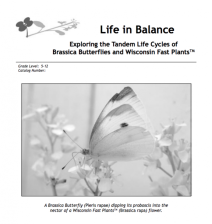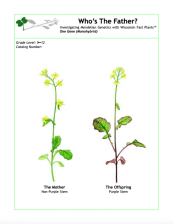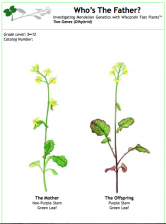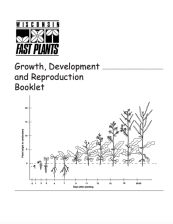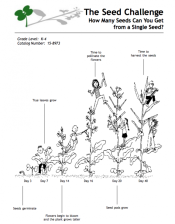Browse Resources
Educational Resources -- Investigations with Fast Plants
Resources | |
|---|---|
This PDF document shows in detail the possible day-to-day learning associated with the 6-week version of the Fast Plants Polycot Selection / Plant Breeding Investigation (aka Option A).
Conducting this selection / plant breeding investigation uses Generation 1 Polycot Fast Plants seed lines, with...
This PDF document shows three calendars side-by-side for comparing the time and materials needed for three different versions of the Fast Plants Mendelian Inheritance Investigation that is commonly called "Who's the Father?"
Option A involves students growing the F1 generation of Fast Plants in...
This PDF document shows in greater detail the possible day-to-day learning associated with the 3-week version of the Fast Plants Polycot Selection Investigation.
Conducting this selection investigation in just 3 weeks involves using Polycot Fast Plants seed lines for both Generation 1 and 2...
This PDF document shows three calendars side-by-side for comparing the time and materials needed for three different versions of the Fast Plants Polycot Selection Investigation.
Option A involves Fast Plants grown in soil, and students select for or against polycots, then produce their own...
Preparing Your Students for the Future: Undergraduate Research Experiences with RapidCycling BrassicThis article with practical instructions about using Fast Plants in undergraduate research experiences was published as an addendum to a workshop given at the 2017 ABLE Conference in Madison, WI. Contains ideas for helping students at high school and undergraduate levels to conduct independent...
This blog post, written by the MiniPCR Team, describes the use of biotechnology kits and equipment (available from multiple suppliers) in the classroom to help students and learners understand the connection between observable phenotypic traits and underlying genotypes. These investigations can be...
This 5-page handout aims to help students and their adult mentors explore topics and questions about the natural world and/or Fast Plants growth and development that could be investigated through research and experimentation. The handout is intended to inspire scientific question development that...
This investigation begins with a phenomenon that is evidenced in most every produce aisle: Many of the vegetables that botanists classify as Brassica look and taste different. This investigation aligns with middle and high school Next Generation Science Standards as well as with agricultural science...
This document includes a timeline and calendar to serve as planning tools for teachers to use when figuring out when to begin the steps associated with conducting a two-generation artificial selection experiment using Fast Plants. This investigation focuses on selection for the stem color trait....
This lesson plan, from the University of Wisconsin-Madisons Wisconsin Fast Plants, is for a high school biology investigation into evolution and artificial selection while using Fast Plants polycot seeds. The lesson plan describes student science performance for in-classroom learning as well as...
This blog post from the University of Wisconsin-Madison's Wisconsin Fast Plants, describes an investigation that educators can implement in the classroom to facilitate students' learning about variation and natural selection through firsthand observations and hands-on data collection in a very short...
This 16-page resource, from Wisconsin Fast Plants, provides a "complete Open Source investigation into ecosystem dynamics that can be adapted to any grade level." In this Google Document, readers will find the investigation includes a lesson plan, descriptions of standards alignment, tips for...
Sign up for a free account on the Gizmo website (https://www.explorelearning.com/index.cfm?method=Controller.dspFreeAccount) for free access to two simulations that were collaboratively developed by the teams at Explore Learning and the Wisconsin Fast Plants Program of the University of...
These data sets were meticulously collected by Dr. Paul Williams in an investigation in which we were interested in learning about how nutrient limitations effect a variety of easily observable and measureable Fast Plant traits. Observations were made and recorded at different points in the plants'...
Download this complete set of lessons for an elementary, NGSS-aligned inquiry that foregrounds engineering practices. During the days that are supported by this investigation, students observe flowers on their 14 to 16 day old Fast Plants along with bee structures, learning to connect how the shape...
This article is designed to help students and teachers think about the nature of various determinants underlying biological variation. Teachers facilitating any selection investigation will find this background information helpful, including those planning for the AP Biology Lab 1 of Big Idea 1:...
Download this complete unit of instructions to conduct an ecosystem inquiry. In this investigation, students have the opportunity to witness first-hand the dynamic relationship between Brassica butterflies and Wisconsin Fast Plants. Students are responsible for tending the butterflies and plants...
In this investigation, students will gather their own evidence to explain how inheritance works. As they observe three generations of Wisconsin Fast Plants, students will unravel a mystery of paternity: What is the father’s phenotype? Is it the same as the mother’s phenotype or the offspring’s...
Download the complete instructions for a high school level inheritance inquiry, using Wisconsin Fast Plants. In this investigation, students gather their own evidence to explain how inheritance works. As they observe three generations of Wisconsin Fast Plants, students unravel a paternity mystery:...
A 32-page booklet, containing complete instructions for activities at each life cycle stage. The booklet also includes important background information about plant physiology and how to grow Fast Plants. A Growth, Development and Reproduction kit is available. You can also conduct all the...
A 23-page PDF file (644 KB) with a complete set of activities for elementary students (also effective in middle school) to learn about the life cycle of flowering plants with a focus on reproduction. Students predict how many seeds their Fast Plant will produce and engage in planting, growing,...
| |
